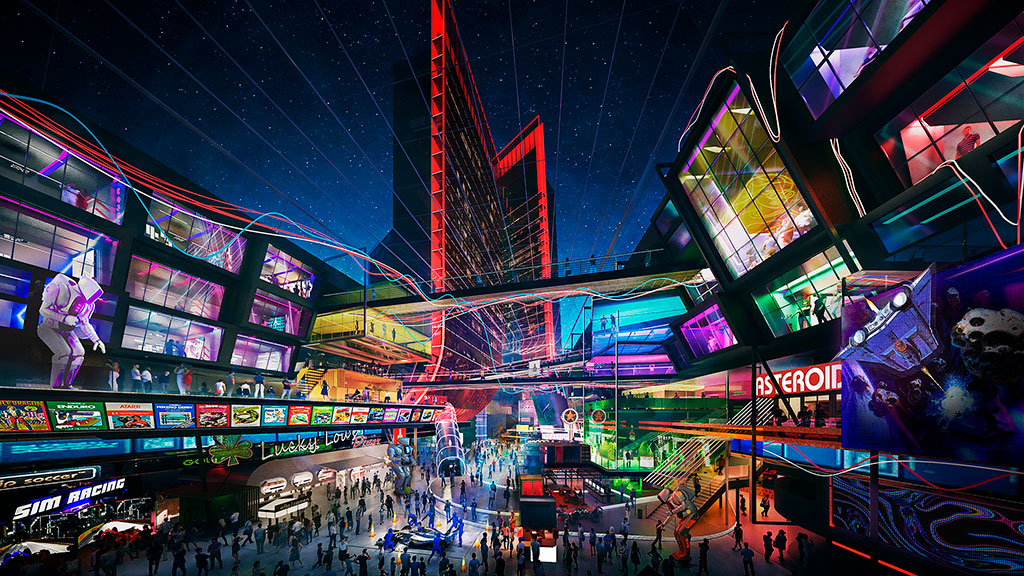Trends to Watch Shaping the Future of Hospitality in Las Vegas and Beyond
May 01, 2024 | Q&A with Candra Mathis and Nicole Dalton
Las Vegas is a city that is continually reinventing itself. From recent additions of high-profile sports teams and stadiums to immersive, entertainment-driven experiences and venues, such as The Sphere, the influence of hospitality-inspired design is transcending beyond traditional hotels and casinos. We sat down with Candra Mathis, Co-Managing Principal of Gensler Las Vegas, and Nicole Dalton, Director of Hospitality based in Gensler’s Las Vegas office, to discuss recent trends in hospitality, from the shrinking gaming floor footprint to the rise of more tailored, residential amenities.
What are some recent trends in hospitality interiors that you’re excited about, or clients are coming to you for?
Nicole Dalton: In Las Vegas, guests want a more tailored, unique approach with a residential feel. They want luxury amenities. It’s the thoughtful touches that are making a difference. Personal care amenities like sleep kits have been successful. For example, Resorts World is putting in Dyson hair dryers and hair wraps in their luxury suites, and for some of their premier guests, they are even embroidering their initials on their pillow cases, just to go above and beyond their competitors. They’re trying to understand their guest preferences to ensure their favorite food & beverages are delivered before they arrive to make their experience more memorable.
At the same time, we’re starting to see a smaller footprint for the gaming floor when we’re doing a masterplan of a casino space. Although the games are getting much larger and taller, the actual footprint of the gaming floor is getting smaller because the amenities are at the forefront, like the food & beverage, spas, and tandem activities. Gaming is no longer the sole source for revenue; we are now seeing that guests are coming to Las Vegas to enjoy many other things than just the casino.
Candra Mathis: With large-scale resorts, it is our goal as designers to bring things down to the human scale. We want to make sure that no matter the scale of the project, we are able to make the guest experience inviting and tactile, and we do this by layering in more residential elements through materiality and furniture, fixtures, and equipment (FF&E). By adding a residential layer, the experience feels more authentic. It feels curated, it feels crafted, it feels unique, and it doesn’t feel like a mass production of every other casino or hotel that you’ve seen.
How does that impact the guest experience, when you’re bringing in newer amenities, changing up the floors, and creating condensed gaming floor places?
ND: We’ve gotten away from theming spaces. We’re making them much more timeless, elegant, and refined. Casino resort developer Steve Wynn is an excellent example of who started this. The Bellagio and The Mirage (soon to become The Hard Rock) are two great examples of this work that have been in Las Vegas since 1988 and 1989, respectively, and the bones of both of the properties are timeless. Mr. Wynn then followed that model through Wynn and Encore. We followed those exact rules on Fontainebleau; less is more, and we wanted to maintain a timeless and elegant design that would last throughout the ages.
CM: I’m so in love with Fontainebleau right now! Upon arrival, I know I am somewhere different than any other hotel on the Strip. This is a great example of a grand hotel that has been thoughtfully layered and crafted to add many layers of not only visual interest, but it is also warm and inviting.
You’ve both talked about “timeless design” becoming a trend, especially in Las Vegas. What other sustainable design measures have hospitality clients embraced?
CM: We are seeing our clients starting to acknowledge the importance of sustainability throughout the industry. There are now many tools at designers’ fingertips to help simplify the process and make it easier for all of us to be sustainable. Within Gensler, we have developed the Gensler Product Sustainability (GPS) Standards, and they aim to do just that by defining minimum sustainability criteria for high-volume, market-ready material categories used in our architecture and interior projects. We have to be more sustainable, especially in hospitality, because it’s an industry that has a turnover every 10 years on design.
If we, as designers, create timeless spaces, then hopefully our clients will not look back in 10 years at their properties and say, “That’s dated.” The project will definitely have the usual wear and tear, but this happens mostly to FF&E, especially if we design the project with natural materiality that will withstand the test of time. When designing a project, our goal is to let the FF&E and the art be the more unique story of the design, and if we can use higher-quality architectural finishes that will last, that alone will help lower a hotel’s carbon footprint.
ND: In Las Vegas, we’re really behind the curve in hospitality and casino design as far as sustainable design. We are taking out massive amounts of carpet in casinos every five to seven years and putting it in landfills. I think that we’re starting to catch up, and manufacturers are now integrating programs that help with the recycling of products after their lifespan. So, we’re trying to be smarter when we’re redesigning casinos and selecting materials that can be recycled once they’re removed from the property, so they don’t go straight to landfill.
How is Las Vegas reinventing itself beyond gaming as a business, leisure, culinary, and sports and entertainment destination?
ND: People are not only coming to Las Vegas for gaming. They come here for our celebrity chefs, Michelin rated restaurants, and iconic nightlife. We are known for always reinventing ourselves. Right now, we are diversifying our economy as a whole with all of the sports and entertainment venues coming in. We are looking at how to modify the gaming floor, as that’s still our primary function here, but we are also looking at how the gaming floor is changing. We want to be more than just a city known for gaming. We’re the entertainment and hospitality capital of the world. If anyone can do it, Las Vegas can.
CM: In addition, there is a huge art scene in Las Vegas that many tourists have no idea about. The arts district near Downtown is vibrant and curated with incredible culinary and nightlife, as well as boutique retail shops. There is also a huge immersive entertainment scene in Las Vegas off the Strip at the moment. AREA 15 is a fantastic example of this!
Have you seen what’s happening in Las Vegas influence other markets or other global hospitality trends?
ND: We’ve seen Las Vegas influence Macao. The Cotai Strip was created because of the Las Vegas Strip, and they brought in The Wynn, The Venetian, and the Sands Macao. A lot of other countries, like Vietnam, Russia, and Cambodia, want to replicate The Strip, but they don’t want to create the infrastructure, so instead, it often fails.
Why do you think Las Vegas has been so successful in this experience economy?
ND: In Las Vegas, the scale of our casinos and the way we design is unlike anything else. Also, I think it’s our customer service and hospitality. We are really good at catering to everyone; we treat you the same, whether you have $5 or $5,000 in your pocket, and that’s what sets us apart. People come here for a fantasy, and we want to continue to create that.
CM: One thing I have realized is that the price of a luxury hotel in Las Vegas is much lower than going anywhere else in the U.S. This lures in guests to spend money and makes the hotels profitable. Even if the guest is not a gambler, they will be spending money on retail or a food & beverage experience.
Does that spirit of reinvention mean that you can have bolder designs, you can try something cooler or more interesting, or clients are willing to push more than in other sectors or markets?
ND: I think we have so much competition here on being bigger and better than the last casino that was built. Everyone wants to be the next biggest thing. If you’re not better than the last one, then no one’s going to come to your property. I think that’s what drives our designs and our creativity. We want to be the best. We want to have the best spaces, the best center bar, and the best attraction.
CM: There is always a conversation with our clients in the Las Vegas market to discuss what hasn’t been done before. Many clients are looking for the bigger and better, as Nicole mentioned, and many are looking to create something that has never been done before. Those types of projects may be the riskiest, in my opinion, because Las Vegas has been successful in the model of a luxury hotel adding in gaming and food & beverage. If there is a boutique brand that wants to be in the market but doesn’t want a casino, they really have to be in a niche location or have a specific point of view to attract guests to be successful.
What’s a favorite project of yours in the market?
ND: Circa Las Vegas did a really good job of defining Las Vegas through the ages. We created different design elements from across the decades of Las Vegas and incorporated them into the design — for example, the casino carpet pattern was inspired by the neon lights used on all of the original casino signage, the guest rooms have vintage inspired wallcovering based off former Las Vegas hotel rooms, and we pulled the iconic “Vegas Vickie” out of retirement and featured her in the center of the casino.
CM: My favorites are Wynn and Encore. I held back for so many years to stay there because I am more attracted to a modern, minimal design aesthetic. However, the first time I stayed here, when I walked into the rooms, I said out loud, “Wow! I get it!” The scale of the rooms, the attention to detail, the beds, and even the scent of the bedding are such a different experience than any other hotel I have stayed at in Las Vegas. And I am pretty sure I have possibly stayed at most of them after traveling here for work for three years straight!
For media inquiries, email .


